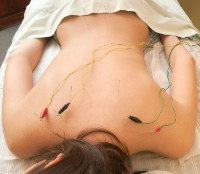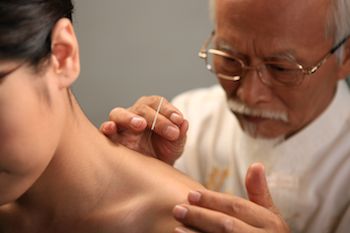New research confirms that acupuncture enhances the delivery of an important chemotherapy drug for the treatment of lung cancer to the lungs while simultaneously protecting the liver and kidneys. Paclitaxel, also known as Taxol, is a mitotic inhibitor used in the treatment of lung, ovarian and breast cancer along with other types including cancers of the head and neck. Extensive research has been underway to minimize the adverse side effects of paclitaxel including mixing it with DHA.  One focus of this type of research is to improve cell targeting so that only the regions requiring the drug are affected. In this experiment, researchers discovered that specific acupuncture points have specific effects on targeting and delivery of paclitaxel. The investigative team notes that acupuncture at specific acupuncture points influences paclitaxel tissue distribution with unique characteristics.
One focus of this type of research is to improve cell targeting so that only the regions requiring the drug are affected. In this experiment, researchers discovered that specific acupuncture points have specific effects on targeting and delivery of paclitaxel. The investigative team notes that acupuncture at specific acupuncture points influences paclitaxel tissue distribution with unique characteristics.
Using high-performance liquid chromatography, the researchers discovered that applying acupuncture needles at acupoint Feishu (BL13) targeted paclitaxel to the lungs more effectively than when using acupoint Lingtai (DU10). Both acupuncture points increased the time of metabolism while significantly reducing distribution of paclitaxel to the liver and kidneys.
The laboratory experiment followed National Institutes of Health guidelines for the care and use of animals in the experimental setting. The team notes that care was given to minimize the suffering of the laboratory mice. Electroacupuncture was applied with 2 Hz rectangular waveform at 7-8 mA for 10 minutes, once per day.
The researchers note that electroacupuncture influences “tissue distribution of Paclitaxel.” Additionally, they posit that tissue distribution changes may be one of the effective action mechanisms by which acupuncture exerts its therapeutic effects during chemotherapy. They concluded, “Acupuncture at Feishu acupoint facilitated the delivery of Paclitaxel to lung more effectively than did acupuncture at Lingtai acupoint.” In addition, both acupuncture points “resulted in an obvious decrease of Paclitaxel distribution in kidney and delayed Paclitaxel distribution in liver.” 
The research team evaluated the results in terms of Traditional Chinese Medicine (TCM) theory. They note that BL13 (Feishu) is commonly used by licensed acupuncturists for the treatment of lung related disorders. They note that Feishu is translated as lung acupoint and is now in common use by licensed acupuncturists for the treatment of side effects due to lung cancer chemotherapy. The researchers add that BL13, according to TCM principles, treats lung disorders by “activation and regulation of qi (energy flow in the human body). Based on these theories, the mechanisms of acupuncture’s therapeutic properties are considered to be linked to the modulation of lung function and the tissue distribution of chemotherapies.”
BL13 is located on the upper back lateral to the lower border of the spinous process of the 3rd thoracic vertebra. It is 1.5 cun lateral to the spine and a cun is approximately 1 inch, however, this type of measurement is variable based on individual human anatomy. BL13 is a lung back shu point thereby designating it as one of the more important lung related points in TCM. According to TCM principles, BL13 regulates lung qi and reduces fever. It is indicated for the treatment of asthma, coughing, chest pain, night sweating, spontaneous sweating and afternoon fevers. This point is never needled deeply, especially perpendicularly or obliquely away from the spine. The standard needling method on humans is 0.5-1 cun obliquely towards the spine or transverse-oblique needling from 1-1.5 cun.
Given BL13’s status as a lung back shu point, it is not surprising that the researchers discovered that it is more effective in targeting the chemotherapy agent towards the lungs. The other point studied, DU10, is located below the spinous process of T6. It is also used by licensed acupuncturists for the treatment of lung conditions such as cough and wheezing. It is also indicated for the treatment of toxins. This point is indicated for the treatment of carbuncles and furuncles (lymphangitis, red-thread boil), other toxic skin conditions and for the treatment of neck and back stiffness and pain.
Equipment
Paclitaxel was obtained from USA Abbott Aires Biosciences (Illinois) and Merk’s acetonitrile was used in the experiment. The team used a high-speed centrifuge, electric glass homogenizer and a Swiss made electronic analytical balancer. The high-performance liquid chromatograph was from Dionex, USA, and the electroacupuncture machine was from Shanghai Medical Apparatus and Instruments Factory, China. The acupuncture needles used in the study were from the Shanghai Shunfeng Medical Instrument Company.
Reference:
Andre, Kim. "Effects of acupuncture on the tissue distribution of Paclitaxel in lung carcinoma mice." Chinese Journal of Integrative Medicine (2014): 1-4.


